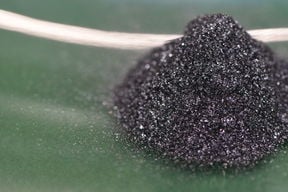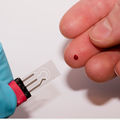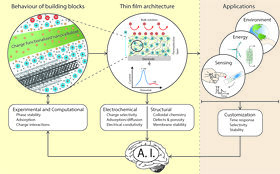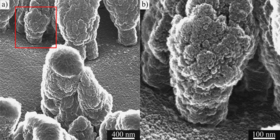Physical Characteristics of Surfaces and Interfaces

Our research areas:
-
Development of hybrid nano carbon thin films for bio-sensing
-
Development of hybrid materials composed of nano cellulose, carbon nanotube/diamond-like carbon thin films
-
Functional thin films using Physical Vapor Deposition methods
Development of hybrid carbon nano thin films for bio-sensing:
Electrochemical methods have proven themselves feasible for monitoring of biomolecules and drugs in vivo and in vitro alike. Moreover, carbon nanomaterials have large surface area, electrocatlytic properties and tailorable surface chemiatry. However, there are many problems, such as sensitivity, specificity and stability, associated with the electrodes that are the material immediately in contact with the biological environment in these sensor devices. Our group utilizes the novel concept of integrated hybrid carbon nanomaterial electrodes to solve the above mentioned problems. This is realized by combining carbon nanotubes (CNTs), graphene, nanodiamonds and graphite, for instance, with diamond-like carbon (DLC) into integrated structures. With these building blocks we can create 2D tailored surfaces as well as 3D functional forms that have the potential to improve the performance in in vivo and in vitro applications that is well above the current level. By combining extensive physical and chemical characterization with electrochemical experiments and multilevel simulations it is possible to further optimize the performance of the developed sensor materials. In addition, these electrodes will serve as the first step toward new interfaces between living and electronic domains.
The research is carried out in close collaboration with Prof. Tomi Laurila group
- Detection of neurotransmitters:
In western countries, approximately 27 % of the population suffer from mental and neurological disorders. The cost of neurotransmitter related disorders is estimated to be close to 800 Billion in Europe alone, and is expected to grow with the ageing of the population. Most of these disorders are related to abnormal brain concentrations of neurotransmitters. Dopamine is one of these neurotransmitters.
Neurotransmitter concentrations are very low (~100 nM) and coexist with high concentrations of other biomolecules that create interference with conventional electrode materials. With novel carbon nanohybrid materials it is possible to selectively detect neurotransmitters, such as dopamine, with high sensitivity, selectivity and sub millisecond response times. In one such approach we combined tetrahedral amorphous carbon with partially reduced graphene oxide to achieve a sensitive and selective electrochemical sensor towards dopamine.
- Fast electrochemical detection of opioids in blood sample by carbon nanohybrid electrodes – FEDOC
The use of pain killers and drug misuse is a constantly increasing societal problem as in addition to their original analgesic effect, they may cause addiction severe side-effects and even death. . Unfortunately, the blood analytics is with the present methods slow and expensive and therefore differential diagnosis of intoxication and poisoning is challenging.
Our innovation is to apply fast detection of opioids in a blood sample by electrochemical method applying hybrid carbon electrode materials developed for neural sensing. The electrodes can be miniaturized and patterned to make inexpensive and disposable electrochemical test strips or chips. One such chip is shown in the picture below. Combining these integrated novel electrode materials with permselective membranes further increases the selectivity of the electrodes. Integrated carbon nanostructured electrodes with permselective polymer membranes have been used to selectively and sensitively detect morphine and codeine, as seen in the picture below.
With these electrodes we have been able to detect morphine and codeine selectively.
The business in health sector is globally growing very fast. Our research consortium comprises leading expertise in carbon nanomaterial production, electrical engineering, electrochemistry, physical and chemical characterization, clinical pharmacology and anesthesiology.
Development of carbon nanomaterial diamond-like carbon thin hybrid films:
Diamond-like Carbon (DLC) with no hydrogen is an amorphous form of 3D as a coating. It is bonded predominantly (up to 80 %) by sp3 bonding but with no long-range order. Hydrogen free DLC coatings have a hardness of over 50 GPa, and elastic modulus of over 500 GPa. The DLC coatings are the most prominent high wear resistant and low coefficient of friction coatings in engineering at the moment.
It may be summarized that carbon nanomaterial networks and thin films with excellent transport properties but modest mechanical properties have been processed. The yield strength is in the range of tens of MPa which is low compared to TPa values obtained for individual carbon nanomaterials. The mechanical strength of the state-of-art networks and thin films do not possess the ultimate high strength measured for individual carbon nanomaterials or DLC.
One can envision that the ultimate future material is a high strength carbon based hybrid which combines the functional carbon nanomaterials in a framework held together by an amorphous diamond-like matrix with a tailored sp2/sp3 bond structure. This material could be called Carbon Nanomaterial – DLC hybrid. Only in very few papers have been published on such Carbon nanomaterial-DLC hybrids.
Carbon nanomaterials in the form of single wall carbon nanotube networks (SWCNTNs) and detonation nanodiamonds (DNDs) have been investigated due to their increasing usage as conductive films, thin film transistors, sensing elements and photonic components. The feasibility of forming carbon nanomaterial – DLC hybrid thin films has been verified both experimentally3,4 as well as by simulations5. XPS analysis (Fig. 1 (a)) of SWCNTN – DLC hybrid indicates high percentage of sp3 carbon fraction correlating to high quality DLC matrix3. Raman analysis of SWCNTN – DLC hybrid indicates that the SWCNTs survive the process and retain most of their functionality3. The mechanical wear resistance of the SWCNTN – DLC hybrid for low and medium load improves by 60% (Fig. 1 (b)) in comparison to uncoated SWCNTNs3. A novel technique for co-depositing DND – DLC hybrid films (Fig. 2 (a), (b)) using a single step room temperature process with controllable parameters has been demonstrated4. This DND-DLC hybrid film has 16% higher hardness and 40% lower wear in comparison to DLC matrix itself (Fig. 2 (c), (d)) even for very low DND concentration of 0.1 vol%4.
The mechanical wear protection offered by DLC matrix to the SWCNT networks is significant and enables the use of SWCNTN – DLC hybrid films for applications requiring mechanically rugged conductive films. The DND – DLC hybrid films exhibit low wear even under high load and repeated wear conditions leading to the conclusion that these hybrid films could be used for tribological applications with performance superior to existing DLC coatings.
- 1 J. Robertson, Materials Science and Engineering: R: Reports, Volume 37, Issues 4-6, 24 May 2002, Pages 129-281.
- 2 K. Holmberg, A. Matthews, Coatings Tribology. Elsevier. 2nd edition, Elsevier, Amsterdam (2009)
- 3 A. Iyer, et al. “Single Walled Carbon Nanotube network - Tetrahedral Amorphous Carbon composite film”, J. Appl. Phys.117, 225302 (2015); doi: 10.1063/1.4922242
- 4 Ajai Iyer, et al.“Nanodiamond embedded ta-C composite film by pulsed filtered vacuum arc deposition from a single target”, Appl. Phys. Lett. 109, 201905 (2016); doi: 10.1063/1.4967985
- 5 Wei Ren, et al., “Conditions for forming composite carbon nanotube-diamond like carbon material that retain the good properties of both materials”, J. Appl. Phys. 118, 194306 (2015); doi: 10.1063/1.4935820
Low friction coatings for high contact pressure loads, reduced wear, corrosion protection and self-cleaning:
Thin film coating to improve non-stick properties of dental restorative instruments. The properties were evaluated with contact angle measurements with dental filler resin and customized dipping equipment.
Superhydrophobic coating consisting of surface structuring by etching + surface stabilization by atomic layer deposition (ALD) + fluoropolymer molecular layer was fabricated to reduce sticking.
- Leppäniemi, Eur. J. Oral Sci., under review.
Corrosion protection of high-speed steel by thin film coatings. Protection by PVD CrN coating was compared to hybrid PVD/ALD coating, where pinholes in CrN are sealed by ALD. Upper left: photographs of samples after corrosion testing. Upper right: linear sweep voltammetry curves.
- Leppäniemi, Thin Solid Films, 2016.
Research group members
- Vasuki Durairaj works on developing nanocellulose based hybrid membranes for improving the selectivity in electrochemical detection of bio-molecules
- Jarkko Etola specializes in developing novel microstructures and composite thin film coatings using physical vapor deposition (PVD) methods such as direct-current magnetron sputtering (DC-MS) and pulsed filtered cathodic vacuum arc (p-FCVA) system. These structures have high impact applications in microelectronics, energy storage and biosensing.

Suggested courses:
- EIT RawMaterials educational project DiENT: digitalized materials science courses, which include an entrepreneurial mindset. See more at: https://eitrawmaterials.eu/course/dient/
Related content:
A new measurement method for strong analgesics can reduce poisoning and overdose deaths
The effects of tramadol vary individually. Now they can be monitored more accurately by quick measuring of drug concentrations.

Jari Koskinen was awarded The Order of the White Rose of Finland
Jari Koskinen received The Order of the White Rose of Finland

Latest publications
Exploring the envelope of physical vapor deposition: Nano- and microstructured films for electrochemical applications
Introduction of an electrochemical point-of-care assay for quantitative determination of paracetamol in finger-prick capillary whole blood samples
Protein Adsorption and Its Effects on Electroanalytical Performance of Nanocellulose/Carbon Nanotube Composite Electrodes
Electrochemical Generation of Hot Electrons in Fully Aqueous Solutions at Tetrahedral Amorphous Carbon Thin Film Electrodes and Electrochemiluminescence Immunoassay of Serum Amyloid A
All-copper Flow Batteries
Nanocellulose / Nanocarbon Composites for Direct Electrochemical Detection of Small Molecules
Role of nanocellulose in tailoring electroanalytical performance of hybrid nanocellulose/multiwalled carbon nanotube electrodes
Accurate Computational Prediction of Core-Electron Binding Energies in Carbon-Based Materials: A Machine-Learning Model Combining Density-Functional Theory and GW
Silica-silicon composites for near-infrared reflection
- Published:
- Updated:

